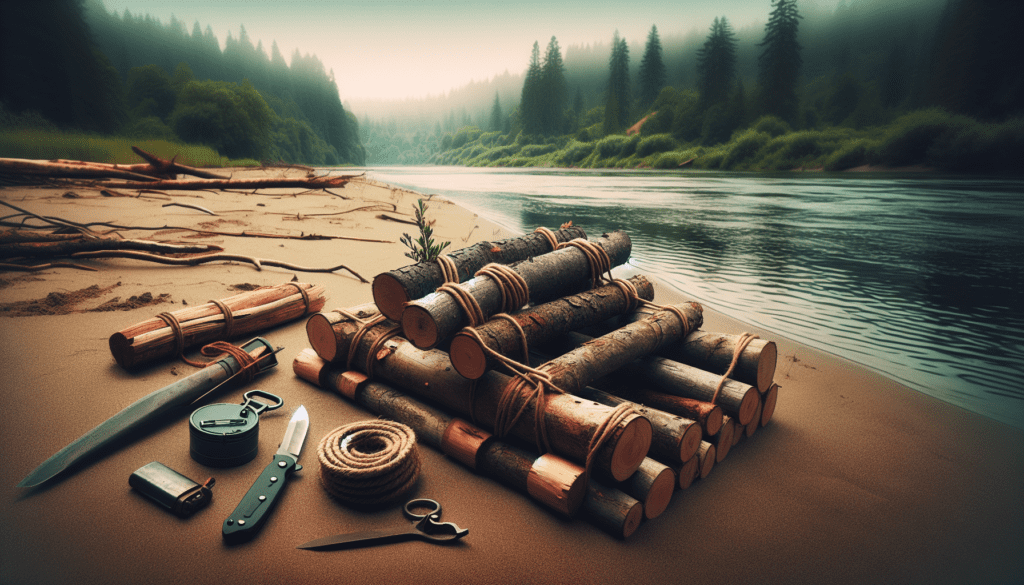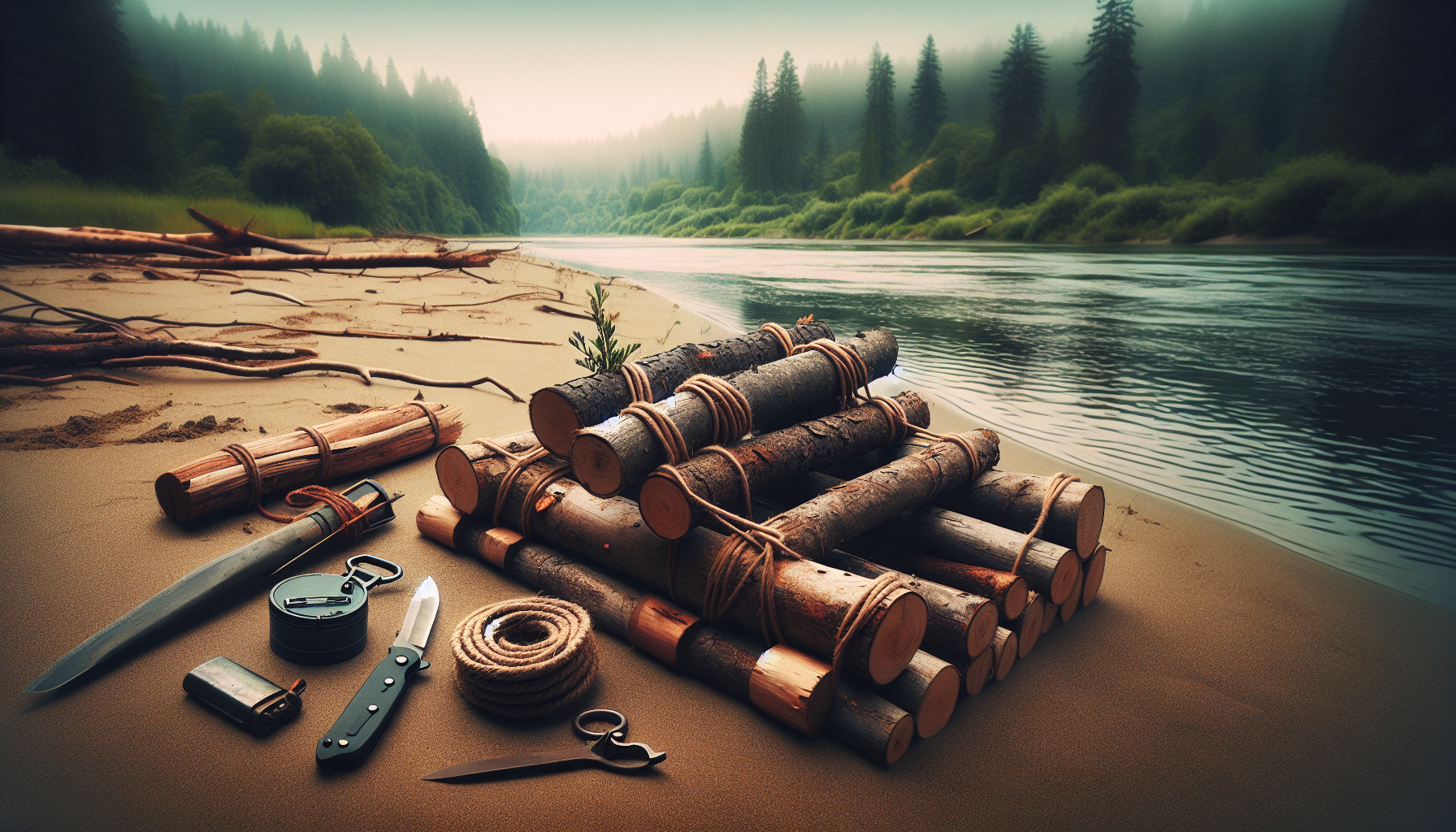Are you in need of a quick and easy way to navigate through water? Look no further than a makeshift raft! In this article, we will provide you with simple step-by-step instructions on how to build your own makeshift raft using readily available materials. Whether you’re planning a fun adventure or find yourself in a survival situation, this guide will help you construct a sturdy and reliable raft that will keep you afloat. So grab your tools and let’s get started!
Materials Needed
To build a makeshift raft, you will need a few essential materials. Here’s a breakdown of what you’ll need:
Logs or barrels
Logs or barrels will serve as the foundation of your raft. These will provide buoyancy and stability to keep your raft afloat. Make sure the logs or barrels are in good condition and free from any cracks or leaks.
Rope or cord
Rope or cord is essential for securing the logs or barrels together and attaching the plywood or planks to the raft base. Opt for strong and durable ropes or cords that can withstand the pressure and tension.
Plywood or wooden planks
Plywood or wooden planks will be used to create a platform on top of the logs or barrels. Ensure that the plywood or planks are sturdy enough to support the weight of the raft and the people on it.
Waterproof tarp or plastic sheet
A waterproof tarp or plastic sheet will provide protection against water and elements. This will help keep your raft dry and prevent any water from seeping through the platform.
Tools such as a saw or hatchet
You’ll need tools like a saw or hatchet to cut the plywood or planks to the desired size and shape. These tools will also come in handy when securing the logs or barrels together.
Paddles or oars
Paddles or oars will be your means of navigating and controlling the raft. Make sure you have enough paddles or oars for everyone on board.
Choosing the Right Location
Before diving into the construction process, it’s important to choose the right location for your makeshift raft. Here are a few factors to consider:
Consider water conditions
Take into account the water conditions of the area where you plan to use your raft. Factors such as tides, currents, and waves can greatly impact the safety and stability of your raft. Choose a location with calm waters and minimal risks.
Check for nearby hazards
Scan the area for any nearby hazards that could pose a danger to your raft and its occupants. These hazards could include rocks, sharp objects, or strong underwater currents. Avoid areas with potential risks to ensure a safe rafting experience.
Ensure accessibility and proximity to help
Choose a location that is easily accessible and in close proximity to help or civilization. In case of any emergencies or unforeseen circumstances, it’s crucial to be able to reach assistance quickly. Being close to help will provide an added layer of safety.

Preparing the Raft Base
The raft base serves as the foundation and primary support for your makeshift raft. Here’s how to prepare it:
Gather and inspect the logs or barrels
Collect the required number of logs or barrels for your raft base. Carefully inspect each log or barrel for any signs of damage or leaks. It’s important to choose sturdy and reliable logs or barrels that will ensure the stability and flotation of your raft.
Measure and cut the plywood or planks
Measure and cut the plywood or wooden planks to the desired size and shape for your raft platform. Ensure that the measurements are accurate and allow for a sufficient amount of space for everyone on board. Use a saw or hatchet to make clean cuts.
Secure the logs or barrels together
Arrange the logs or barrels in a rectangular or square shape to form the base of your raft. Use rope or cord to securely fasten the logs or barrels together. Make sure the connections are tight and sturdy to prevent any wobbling or instability.
Attach the plywood or planks to the top
Place the cut plywood or planks on top of the secured logs or barrels. Use rope or cord to attach the plywood or planks to the base, ensuring that they are tightly and securely fastened. This will create a stable platform for the next steps in building your raft.
Building the Frame and Platform
The frame and platform of your makeshift raft will provide additional stability and structural integrity. Follow these steps to build the frame and platform:
Create a frame with additional logs or planks
Using additional logs or planks, create a frame around the perimeter of the raft base. This frame will help support the edges of the platform and prevent them from sagging or collapsing. Secure the frame to the raft base using rope or cord.
Secure the frame to the raft base
Ensure that the frame is securely fastened to the raft base. Double-check the connections and tighten any loose ropes or cords. It’s crucial to have a strong and stable foundation to build upon.
Add cross beams for stability
To further enhance the stability of your raft, add cross beams within the frame. These cross beams will provide additional support and prevent any excessive flexing or bending of the platform. Secure the cross beams to the frame and raft base using rope or cord.
Ensure platform size and weight distribution
Make sure that the platform size is appropriate for your needs. Consider the number of people who will be on the raft and any additional equipment or supplies you plan to bring. Also, evenly distribute the weight on the platform to maintain balance and stability.

Adding Buoyancy and Stability
Buoyancy and stability are crucial for a successful makeshift raft. Here’s how to achieve it:
Attach additional barrels for buoyancy
To increase the buoyancy of your raft, attach additional barrels to the underside of the platform. These barrels will provide extra flotation and help keep the raft afloat. Ensure that the barrels are securely fastened and evenly distributed.
Distribute the buoyancy evenly
Evenly distribute the buoyancy by placing the additional barrels in strategic locations under the platform. This will help maintain balance and prevent the raft from tilting or listing to one side. Regularly check the buoyancy and make any necessary adjustments.
Make sure the raft remains stable
Test the stability of the raft by gently rocking or shaking it from side to side. If the raft feels wobbly or unsteady, reinforce the connections, adjust the barrel placement, or make any necessary modifications to ensure a stable raft.
Waterproofing the Raft
To protect your raft from water damage and ensure longevity, you’ll need to waterproof it. Follow these steps:
Cover the platform with a tarp or plastic sheet
Place a waterproof tarp or plastic sheet over the entire platform of your raft. This will create a barrier between the platform and the water, preventing any moisture from seeping through. Ensure that the tarp or plastic sheet covers the platform completely.
Secure the covering tightly
Use ropes or cords to tightly secure the tarp or plastic sheet to the edges of the raft platform. This will prevent the covering from moving or coming loose while you’re on the water. Make sure the covering is taut and free from any wrinkles or folds.
Seal any gaps or openings
Inspect the entire raft for any gaps or openings where water could potentially penetrate. Seal these gaps or openings using waterproof tape or sealants. Pay special attention to the connections between the logs or barrels and the plywood or planks.
Consider using waterproof sealants
For added protection and durability, consider applying a waterproof sealant to the entire raft. Waterproof sealants will further repel water and provide an extra layer of defense against moisture and the elements.
Securing the Raft
To ensure the safety and stability of your makeshift raft, it’s important to secure it properly. Here’s how:
Attach ropes or cords to anchor points
Attach ropes or cords to anchor points on the raft, such as the corners of the platform or the frame. These anchor points will help secure the raft in place and prevent it from drifting away or being carried by the current.
Ensure proper tension and stability
Ensure that the ropes or cords attached to the anchor points are properly tensioned. They should be tight enough to keep the raft in place but not so tight that they cause strain or damage to the raft. Regularly check the tension and make any necessary adjustments.
Test the raft’s security
Before heading out onto the water, perform a thorough test of the raft’s security. Apply gentle pressure and give the raft a few light shakes to ensure that it remains stable and secure. If there are any signs of instability or loose connections, address them before embarking on your rafting adventure.
Navigating and Controlling the Raft
Once your makeshift raft is ready, it’s time to learn how to navigate and control it effectively. Follow these tips:
Use paddles or oars to steer
Utilize paddles or oars to steer and maneuver the raft. Assign one or more people to handle the paddles or oars, depending on the size of your raft and the number of occupants. Practice proper paddling techniques, such as using alternate strokes on both sides to maintain a straight trajectory.
Practice maneuvering and turning
Practice maneuvering and turning the raft in a controlled environment before venturing into more challenging waters. Learn how to execute precise turns and adjust your paddling techniques accordingly. Mastering these skills will help you navigate your raft with ease.
Be cautious of wind and currents
Be mindful of external factors such as wind and currents, as they can greatly affect your raft’s direction and speed. Take these factors into account when planning your route and adjust your paddling techniques accordingly. Remember to plan your return route with wind and currents in mind.
Safety Measures
Safety should be your top priority when embarking on a rafting adventure. Here are some essential safety measures to keep in mind:
Wear life jackets or personal flotation devices
Ensure that everyone on the raft wears a properly fitting life jacket or personal flotation device. Life jackets and flotation devices are crucial for buoyancy and safety in case of any accidents or emergencies. Make sure they are approved and suited for the water conditions you’ll be rafting in.
Bring essential safety equipment and supplies
Carry essential safety equipment and supplies on board your raft. These may include a first aid kit, a whistle or signaling device, a waterproof flashlight, and a knife or multi-tool. Additionally, pack ample drinking water and some non-perishable food items in case of unexpected delays.
Inform others about your rafting plans
Before setting off, inform someone responsible about your rafting plans. Let them know your intended route, expected duration, and any designated stop points along the way. This ensures that someone is aware of your itinerary and can alert authorities if you fail to return as planned.
Assessing and Monitoring Conditions
Regularly assessing and monitoring the conditions is crucial for a safe rafting experience. Here’s what you need to do:
Regularly check weather forecasts
Stay updated on the latest weather forecasts for the area where you plan to raft. Sudden changes in weather can significantly impact water conditions and overall safety. Avoid rafting in severe weather conditions such as thunderstorms or high winds.
Monitor water levels and currents
Keep an eye on water levels and currents before and during your rafting trip. High water levels or strong currents can make rafting more challenging and potentially dangerous. If water conditions become unfavorable, consider postponing or canceling your rafting plans.
Adjust your rafting plans accordingly
Based on the assessment of weather conditions, water levels, and currents, be prepared to adjust your rafting plans if necessary. Your safety should always come first, and it’s important to prioritize making responsible decisions that align with the current conditions.
With these comprehensive guidelines, you’re now equipped with the knowledge to build a makeshift raft and embark on a thrilling rafting adventure. Remember to prioritize safety at all times, be prepared for unexpected circumstances, and enjoy the experience of navigating the open waters on your very own raft. Happy rafting!

